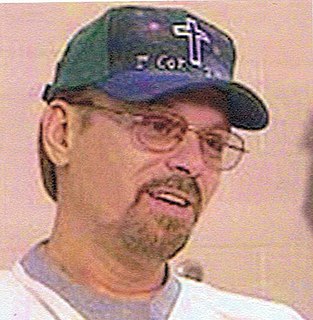United States v. Dominguez Benitez, 542 U.S. 74 (2004), was a United States Supreme Court case in which the Court ruled that, in a criminal proceeding in federal court, a defendant who does not alert the district court to a possible violation of Rule 11 of the Federal Rules of Criminal Procedure must show on appeal that the violation affirmatively affected his rights in order to obtain reversal of his conviction by guilty plea. Rule 11, which pertains to criminal prosecutions in United States federal courts only, governs the offering of plea bargains to criminal defendants and the procedures district courts must employ to ensure that the defendant knows of and properly waives his trial-related constitutional rights.
Skinner v. State of Oklahoma, ex rel. Williamson, 316 U.S. 535 (1942), was the United States Supreme Court ruling that held that laws permitting the compulsory sterilization of criminals are unconstitutional as it violates a person's rights given under the 14th Amendment of the United States Constitution, specifically the Equal Protection Clause, as well as the Due Process Clause. The relevant Oklahoma law applied to "habitual criminals", but the law excluded white-collar crimes from carrying sterilization penalties.
Hill v. McDonough, 547 U.S. 573 (2006), was a United States Supreme Court case challenging the use of lethal injection as a form of execution in the state of Florida. The Court ruled unanimously that a challenge to the method of execution as violating the Eighth Amendment to the United States Constitution properly raised a claim under 42 U.S.C. § 1983, which provides a cause of action for civil rights violations, rather than under the habeas corpus provisions. Accordingly, that the prisoner had previously sought habeas relief could not bar the present challenge.

The Supreme Court of the United States handed down six per curiam opinions during its 2004 term, which began October 4, 2004 and concluded October 3, 2005.
House v. Bell, 547 U.S. 518 (2006), is a United States Supreme Court case challenging the permissibility of new DNA forensic evidence that becomes available post-conviction, in capital punishment appeals when those claims have defaulted pursuant to state law. The Court found that admitting new DNA evidence was in line with Schlup v. Delo (1995), which allows cases to be reopened in light of new evidence.

Philip Ray Workman was a death row inmate executed in Tennessee on May 9, 2007. He was convicted in 1982 for the murder of a police officer following a robbery of a Wendy's restaurant in Memphis, Tennessee, and sentenced to death by lethal injection.

The Supreme Court of the United States handed down six per curiam opinions during its 2007 term, which began October 1, 2007 and concluded September 30, 2008.
District Attorney's Office for the Third Judicial District v. Osborne, 557 U.S. 52 (2009), was a case in which the United States Supreme Court decided that the Constitution's due process clause does not require states to turn over DNA evidence to a party seeking a civil suit under 42 U.S.C. § 1983.

Paul George Cassell is a former United States District Judge of the United States District Court for the District of Utah, who is currently the Ronald N. Boyce Presidential Professor of Criminal Law and University Distinguished Professor of Law at the S.J. Quinney College of Law at the University of Utah. He is best known as an expert in, and proponent of, victims' rights.

Amul Roger Thapar is an American attorney and jurist serving as a United States Circuit Judge of the United States Court of Appeals for the Sixth Circuit. He is a former United States District Judge of the United States District Court for the Eastern District of Kentucky and former United States Attorney for the Eastern District of Kentucky. Thapar was the first South Asian federal judge in American history. He was also President Trump's first Court of Appeals appointment and Trump's second judicial appointment after Justice Neil Gorsuch. Thapar is frequently discussed as a candidate for the Supreme Court of the United States.
Harbison v. Bell, 556 U.S. 180 (2009), was a decision by the Supreme Court of the United States that held that federal law gave indigent death row inmates the right to federally appointed counsel to represent them in post-conviction state clemency proceedings, when the state has declined to do so. Certiorari was granted by the Supreme Court on June 23, 2008.

The Supreme Court of the United States handed down nineteen per curiam opinions during its 2009 term, which began on October 5, 2009, and concluded October 3, 2010.
Tapia v. United States, 564 U.S. 319 (2011), was a United States Supreme Court case in which the Court held that a federal court cannot give a criminal defendant a longer sentence to promote rehabilitation.
United States v. Jones, 565 U.S. 400 (2012), was a landmark United States Supreme Court case which held that installing a Global Positioning System (GPS) tracking device on a vehicle and using the device to monitor the vehicle's movements constitutes a search under the Fourth Amendment.
Smith v. Spisak, 558 U.S. 139 (2010), was a United States Supreme Court decision on the applicability of the Antiterrorism and Effective Death Penalty Act of 1996. It further examined issues of previous court decisions on jury instructions and the effectiveness of counsel.
Tanco v. Haslam was the lead case in the dispute of same-sex marriage in Tennessee. A U.S. District Court granted a preliminary injunction requiring the state to recognize the marriages of the plaintiffs, three same-sex couples. The court found the equal protection analysis used in Bourke v. Beshear, a case dealing with a comparable Kentucky statute "especially persuasive." On April 25, 2014, that injunction was stayed by the Sixth Circuit Court of Appeals. Tanco was appealed to the Sixth Circuit, which reversed the district court and upheld Tennessee's refusal to recognize same-sex marriages from other jurisdictions on November 6.

The Supreme Court of the United States handed down eight per curiam opinions during its 2014 term, which began October 6, 2014 and concluded October 4, 2015.

The Supreme Court of the United States handed down eighteen per curiam opinions during its 2015 term, which began October 5, 2015 and concluded October 2, 2016.
Bell v. Cone, 535 U.S. 685 (2002), was a Supreme Court of the United States case that upheld a death sentence despite the defendant's argument that he should not be sentenced to death because he was suffering from drug-induced psychosis when he committed the crimes. Cone also argued that he was denied effective assistance of counsel because his attorney failed to present sufficient mitigating evidence during the sentencing phase of his trial and that his attorney inappropriately waived his final argument during the sentencing phase. In an 8–1 opinion written by Chief Justice William Rehnquist, the United States Supreme Court denied Cone's petition for a writ of habeas corpus. The Court held that the actions taken by Cone's attorney during the sentencing phase were "tactical decisions" and that the state courts that denied Cone's appeals did not unreasonably apply clearly established law. Justice John Paul Stevens wrote a dissenting opinion in which he argued that Cone was denied effective assistance of counsel because his attorney failed to "subject the prosecution's case to meaningful adversarial testing."
Lafler v. Cooper, 566 U.S. 156 (2012), was a United States Supreme Court case in which the Court clarified the Sixth Amendment standard for reversing convictions due to ineffective assistance of counsel during plea bargaining. The Court ruled that when a lawyer's ineffective assistance leads to the rejection of a plea agreement, a defendant is entitled to relief if the outcome of the plea process would have been different with competent advice. In such cases, the Court ruled that the Sixth Amendment requires the trial judge to exercise discretion to determine an appropriate remedy.




